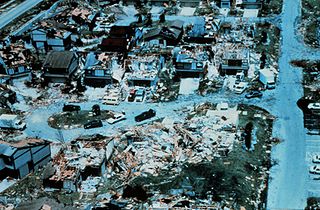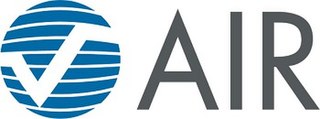Related Research Articles

Insurance is a means of protection from financial loss in which, in exchange for a fee, a party agrees to compensate another party in the event of a certain loss, damage, or injury. It is a form of risk management, primarily used to hedge against the risk of a contingent or uncertain loss.

Lloyd's of London, generally known simply as Lloyd's, is an insurance and reinsurance market located in London, England. Unlike most of its competitors in the industry, it is not an insurance company; rather, Lloyd's is a corporate body governed by the Lloyd's Act 1871 and subsequent Acts of Parliament. It operates as a partially-mutualised marketplace within which multiple financial backers, grouped in syndicates, come together to pool and spread risk. These underwriters, or "members", are a collection of both corporations and private individuals, the latter being traditionally known as "Names".
Terrorism insurance is insurance purchased by property owners to cover their potential losses and liabilities that might occur due to terrorist activities.

Reinsurance is insurance that an insurance company purchases from another insurance company to insulate itself from the risk of a major claims event. With reinsurance, the company passes on ("cedes") some part of its own insurance liabilities to the other insurance company. The company that purchases the reinsurance policy is called a "ceding company" or "cedent" or "cedant" under most arrangements. The company issuing the reinsurance policy is referred to as the "reinsurer". In the classic case, reinsurance allows insurance companies to remain solvent after major claims events, such as major disasters like hurricanes and wildfires. In addition to its basic role in risk management, reinsurance is sometimes used to reduce the ceding company's capital requirements, or for tax mitigation or other purposes.

Earthquake insurance is a form of property insurance that pays the policyholder in the event of an earthquake that causes damage to the property. Most ordinary homeowners insurance policies do not cover earthquake damage.
Financial Reinsurance, is a form of reinsurance which is focused more on capital management than on risk transfer. In the non-life segment of the insurance industry this class of transactions is often referred to as finite reinsurance.

Catastrophe bonds are risk-linked securities that transfer a specified set of risks from a sponsor to investors. They were created and first used in the mid-1990s in the aftermath of Hurricane Andrew and the Northridge earthquake.
"Stochastic" means being or having a random variable. A stochastic model is a tool for estimating probability distributions of potential outcomes by allowing for random variation in one or more inputs over time. The random variation is usually based on fluctuations observed in historical data for a selected period using standard time-series techniques. Distributions of potential outcomes are derived from a large number of simulations which reflect the random variation in the input(s).
Reinsurance sidecars, conventionally referred to as "sidecars", are financial structures that are created to allow investors to take on the risk and return of a group of insurance policies written by an insurer or reinsurer and earn the risk and return that arises from that business. A re/insurer will only pay ("cede") the premiums associated with a book of business to such an entity if the investors place sufficient funds in the vehicle to ensure that it can meet claims if they arise. Typically, the liability of investors is limited to these funds. These structures have become quite prominent in the aftermath of Hurricane Katrina as a vehicle for re/insurers to add risk-bearing capacity, and for investors to participate in the potential profits resulting from sharp price increases in re/insurance over the four quarters following Katrina. An earlier and smaller generation of sidecars were created after 9/11 for the same purpose.
Alternative risk transfer is the use of techniques other than traditional insurance and reinsurance to provide risk-bearing entities with coverage or protection. The field of alternative risk transfer grew out of a series of insurance capacity crises in the 1970s through 1990s that drove purchasers of traditional coverage to seek more robust ways to buy protection.
Industry loss warranties (ILWs), are a type of reinsurance contract used in the insurance industry through which one party will purchase protection based on the total loss arising from an event to the entire insurance industry above a certain trigger level rather than their own losses.

CRESTA (Catastrophe Risk Evaluation and Standardizing Target Accumulations) was founded as a joint project of Swiss Reinsurance Company, Gerling-Konzern Globale Reinsurance Company, and Munich Reinsurance Company. CRESTA has set itself the aim of establishing a globally uniform system for the accumulation risk control of natural hazards - particularly earthquakes, storms and floods. Those risk zones are essentially based on the observed and expected seismic activity, as well as on other natural disasters, such as droughts, floods and storms. CRESTA zones regard the distribution of insured values within a region or country for easier assessment of risks. CRESTA Zones are the essential basis for reinsurance negotiation and portfolio analysis. Nowadays, CRESTA sets widely accepted standards which apply throughout the international insurance industry. CRESTA zone information is used by most insurers for assessing the insurance catastrophe premiums they will charge.
Solvency II Directive 2009 is a Directive in European Union law that codifies and harmonises the EU insurance regulation. Primarily this concerns the amount of capital that EU insurance companies must hold to reduce the risk of insolvency.
Insurance in the United States refers to the market for risk in the United States, the world's largest insurance market by premium volume. According to Swiss Re, of the $6.861 trillion of global direct premiums written worldwide in 2021, $2.719 trillion (39.6%) were written in the United States.
Satellite insurance is a specialized branch of aviation insurance in which, as of 2000, about 20 insurers worldwide participate directly. Others participate through reinsurance contracts with direct providers. It covers three risks: relaunching the satellite if the launch operation fails; replacing the satellite if it is destroyed, positioned in an improper orbit, or fails in orbit; and liability for damage to third parties caused by the satellite or the launch vehicle.
Insurance-linked securities (ILS) are broadly defined as financial instruments whose values are driven by insurance loss events. Those such instruments that are linked to property losses due to natural catastrophes represent a unique asset class, the return from which is uncorrelated with that of the general financial market.
Insurability can mean either whether a particular type of loss (risk) can be insured in theory, or whether a particular client is insurable for by a particular company because of particular circumstance and the quality assigned by an insurance provider pertaining to the risk that a given client would have.
Caribbean Catastrophe Risk Insurance Facility Segregated Portfolio Company is an insurance company headquartered in the Cayman Islands. The sixteen original member-countries of CCRIF included participants in CARICOM, and the membership of the Board of Directors is selected by CARICOM and by the Caribbean Development Bank.

Verisk Extreme Event Solutions (formerly AIR Worldwide) is an American risk modeling and data analytics company headquartered in Boston, Massachusetts, with customers in insurance, reinsurance, financial services, and government markets. Verisk Extreme Event Solutions specializes in catastrophe modeling software and services to manage the probability of loss from natural catastrophes, terrorism, pandemics, casualty catastrophes, and cyber incidents. It is led by current President Bill Churney and operates nine offices internationally.
Cuthbert Eden Heath OBE, DL was a British insurance businessman, underwriter, broker, and syndicate owner at Lloyd's of London from 1880 until 1939. A relentless innovator and novel risk-taker, he has been called "the father of modern insurance", "the maker of modern Lloyd's", and "the father of non-marine insurance at Lloyd's", having through his actions transformed Lloyd's from a British marine-only insurer to the complex and varied international general and specialty-risk insurer it is today, and having cemented Lloyd's sterling reputation, as a reliable insurer which promptly and fully paid all valid claims, in the U.S. and throughout the world.
References
- ↑ Mitchell-Wallace, K. Jones, M., Hillier, J. K., Foote, M. (2017) Natural catastrophe risk management and modelling: A practitioner’s guide. Wiley ISBN 978-1118906040.
- ↑ "NatCat Models" (PDF). Schweizerische Aktuarvereinigung. Retrieved December 23, 2019.
- ↑ Edwards, Scott. The Chaos of Forced Migration: A Means of Modeling Complexity for Humanitarian Ends
- ↑ Kaczmarska, Jo; Jewson, Stephen; Bellone, Enrica (2018-03-01). "Quantifying the sources of simulation uncertainty in natural catastrophe models". Stochastic Environmental Research and Risk Assessment. 32 (3): 591–605. doi: 10.1007/s00477-017-1393-0 . ISSN 1436-3259.
- ↑ Malyk, Dmytro (2014-05-15). "Presentation: Introduction to Cat Modeling". Slideshare.net. Retrieved 2019-12-23.
- ↑ "About Catastrophe Modeling". www.air-worldwide.com. Retrieved 2019-12-23.
- ↑ Extreme Events and Property Lines Committee (July 2018). "USES OF CATASTROPHE MODEL OUTPUT" (PDF). American Academy of Actuaries. Retrieved December 23, 2019.
- ↑ "Overview — Oasis LMF 0.1.0 documentation". oasislmf.github.io. Retrieved 2019-12-23.
- ↑ "Association for Cooperative Operations Research and Development". acord.org. Retrieved 2019-12-23.